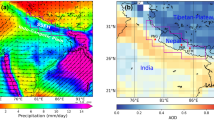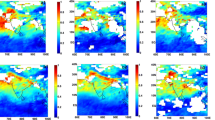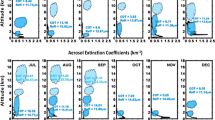Abstract
Using Total Ozone Mapping Spectrometer Aerosol Index (AI) and NCEP/NCAR reanalysis clouds data for the period 1979–1992, the influence of aerosol on the clouds (low and high cloud cover) over the Indo-Gangetic Plain (IGP) in India has been brought out for the first time in the present study. AI shows increasing tendency over the IGP suggesting that aerosol loading over this region increased significantly during the study period. In our analysis, High Cloud Cover (HCC) shows increasing trend and Low Cloud Cover (LCC) shows decreasing trend over the IGP during the same period. During pre-monsoon season when aerosol loading is more, HCC increases in positive correlation with AI. On the other hand, LCC show decreasing trend and is anti-correlated with AI. During summer monsoon, aerosol shows increasing trend but their effect on HCC and LCC is not seen to be significant. Similarly, the role of humidity on aerosol induced changes in HCC and LCC over the IGP region was also analyzed. In the low to moderate humid areas of IGP region (western and middle IGP), increasing AI leads to increase in HCC and decrease in LCC. On the other hand, in high humid areas (eastern IGP), increase in AI does not show any significant effect on HCC, but LCC shows positive trend. Therefore, we strongly argue that increasing aerosol loading enhances Cloud Condensation Nuclei over the region which in turn, alters the microphysical properties of clouds by reducing the size of cloud droplets, and atmospheric humidity controls the aerosol effect on clouds. During the recent period (2005–2010), similar features have also been observed over the IGP region.









Similar content being viewed by others
References
Ackerman AS, Toon OB, Stevens DE, Heymsfiels AJ, Ramamathan V, Welton EJ (2000) Reduction of tropical cloudiness by soot. Science 288:1042–1047
Albrecht BA (1989) Aerosol, cloud microphysics, and fractional cloudiness. Science 245:1227–1230
Andreae MO, Artaxo P, Brandão C, Carswell FE, Ciccioli P, da Costa AL, Culf AD, Esteves JL, Gash JHC, Grace J, Kabat P, Lelieveld J, Malhi Y, Manzi AO, Meixner FX, Nobre AD, Nobre C, Ruivo MdLP, Silva-Dias MA, Stefani P, Valentini R, von Jouanne J, Waterloo MJ (2002) Biogeochemical cycling of carbon, water, energy, trace gases, and aerosols in Amazonia: the LBAEUSTACH experiments. J Geophys Res 107(D20):8066. doi:10.1029/2001JD000524
Andreae MO, Rosenfeld D, Artaxo P, Costa AA, Frank GP, Longo KM, Silva-Dias MAF (2004) Smoking rain clouds over the Amazon. Science 303:1337–1342
Bedacht E, Gulev SK, Macke A (2007) Intercomparison of global cloud cover fields over oceans from the VOS observations and NCEP/NCAR reanalysis. Int J Climatol 27:1707–1719
Bréon FM, Tanré D, Generoso S (2002) Aerosol effect on cloud droplet size monitored from satellite. Science 295. doi:10.1126/science.1066434
Census of India (2001) India office of the registrar general and census commissioner, ministry of home affair. Gov. of India, New Delhi
Chameides WL, Luo C, Saylor R, Streets D, Huang Y, Bergin M (2002) Correlation between model-calculated anthropogenic aerosols and satellite-derived cloud optical depths: indication of indirect effect. J Geophys Res 107. doi:10.1029/2000JD000208
Collier JC, Zhang GJ (2009) Aerosol direct forcing of the summer Indian monsoon as simulated by the NCAR CAM3. Clim Dyn 32:313–332
Feingold G, Remer LA, Ramaprasad J, Kaufman YJ (2001) Analysis of smoke impacts on clouds in Brazilian biomass burning regions: an extension of Twomey’s approach. J Geophys Res 106(D19):22907–22922
Feingold G, Eberhard Wynn L, Veron Dana E, Previdi M (2003) First measurements of the Twomey indirect effect using ground-based remote sensors. Geophys Res Lett 30:1287. doi:10.1029/2002GL016633
Feingold G, Jiang H, Harrington JY (2005) On smoke suppression of clouds in Amazonia. Geophys Res Lett 32:L02840. doi:10.1029/2004GL021369
Ghude Sachin D, Fadnavis S, Beig G, Polade SD, Van der ARJ (2008) Detection of surface emission hotspots, trends and seasonal cycle from satellites-retrieved NO2 over India. J Geophys Res 113. doi:10.1029/2007JD009615
Ghude SD, Kulkarni SH, Kulkarni PS, Kanawade VP, Fadnavis S, Pokhrel S, Jena C, Beig G, Bortoli D (2011) Anomalous low tropo-spheric column ozone over Eastern India during severe drought event of monsoon 2002: a case study. Environ Sci Pollut Res 18:1442–1455
Girolamo LD, Bond TC, Bramer D, Diner DJ, Fettinger F, Kahn RA, Martonchik JV, Ramana MV, Ramanathan V, Rasch PJ (2004) Analysis of multi-angle imaging spectro-radiometer (MISR) aerosol optical depths over greater India during winter 2001–2004. Geophys Res Lett 31:L23115. doi:10.1029/2004GL021273
Griggs JA, Bamber JL (2008) Assessment of cloud cover characteristics in satellite datasets and reanalysis products for Greenland. J Clim 21:1837–1849
Gunn R, Phillips BB (1957) A experimental investigation of the effect of air pollution on the initiation of rain. J Meteorol 14:272–280
Hansen J, Sato M, Ruedy R (1997) Radiative forcing and climate response. J Geophys Res 102:6831–6864
Intergovernmental Panel on Climate Change (IPCC) (1995) Climate change 1994: radiative forcing of climate change and an evaluation of the IPCC IS92 emission scenario. In: Houghton JT, Meira Filho LG, Bruce J, Lee H, Callendar BA, Haites E, Harris N, Maskell K (eds) Cambridge Univ Press, New York, p 339
Jacobson MZ (2006) Effects of externally-through-internally-mixed soot inclusions within clouds and precipitation on global climate. Phys Chem A 110(21):6860–6873
Jiang H, Xue H, Teller A, Feingold G, Levin Z (2006) Aerosol effects on the lifetime of shallow cumulus. Geophys Res Lett 33:L14806. doi:10.1029/2006GL026024
Kalnay E, Kanamitsu M, Kister R, Collins W, Deaven D, Gandin L, Iredell M, Saha S, White G, Woollen J, Zhu Y, Leetmaa A, Reynolds B, Chelliah M, Ebisuzaki W, Higgins W, Janowiak J, Mo KC, Ropelewski C, Wang J, Jenne R, Joseph D (1996) The NCEP/NCAR 40-year reanalysis project. Bull Am Meteorol Soc 77:437–471
Kaufman YJ, Fraser RS (1997) The effect of smoke particles on clouds and climate forcing. Science 277:1636–1639
Kaufman YJ, Koren I (2006) Smoke and pollution aerosol effect on cloud cover. Science 313:655–658. doi:10.1126/science.1126232
Kaufman YJ, Koren I, Remer LA, Rosenfeld D, Rudich Y (2005a) The effect of smoke, dust, and pollution aerosol on shallow cloud development over the Atlantic ocean. Proc Nat Acad Sci 102(32):11207–11212
Kaufman YJ, Koren I, Remer LA, Rosenfeld D, Rudich Y (2005b) The effect of smoke, dust, and pollution aerosol on shallow cloud development over the Atlantic ocean. Proc Nat Acad Sci USA 102(32):11207–11212
Kawamoto K (2006) Relationships between cloud properties and precipitation amount over the Amazon basin. Atmos Res 82:239–247
Khain AP, Rosenfeld D, Pokrovsky A (2005) Aerosol impact on the dynamics and microphysics of deep convective clouds. Q J R Meteorol Soc 131(611):2639–2663
Khain A, BenMoshe N, Pokrovsky A (2008) Factors determining the impact of aerosols on surface precipitation from clouds: attempt of classification. J Atmos Sci 65:1721–1748
Koch D, Del Genio AD (2010) Black carbon semi-direct effects on cloud cover: review and synthesis. Atmos Chem Phys 10:7685–7696
Koren I, Kaufman YJ, Rosenfeld D, Remer LA, Rudich Y (2005) Aerosol invigoration and restructuring of Atlantic convective clouds. Geophys Res Lett 32:L14828. doi:10.1029/2005GL023187
Krishnamurti TN, Chakraborty A, Martin A, Lau KM, Kim KM, Sud YC, Walker G (2009) Impact of Arabian Sea pollution on the Bay of Bengal winter monsoon rains. J Geophys Res 114:D06213. doi:10.1029/2008JD010679
Kruger O, Grassl H (2004) Albedo reduction by absorbing aerosols over China. Geophys Res Lett 31:L02108. doi:10.1029/2003GL019111
Lal DM, Ghude Sachin D, Patil SD, Kulkarni Santosh H, Jena C, Tiwari S, Srivastav Manoj K (2012) Tropospheric ozone and aerosol long-term trends over the Indo-Gangetic Plain (IGP) region, India. Atmos Res. doi:10.1016/j.atmosres.2012.02.014
Lau K-M, Kim KM (2006) Observational relationships between aerosol and Asian monsoon rainfall, and circulation. Geophys Res Lett 33:L21810. doi:10.1029/2006GL027546
Lau WKM, Kim KM (2010) Fingerprinting the impacts of aerosols on long-term trends of the Indian summer monsoon regional rainfall. Geophys Res Lett 37:L16705. doi:10.1029/2010GL043255
Lau KM, Kim KM, Hsu NC, Singh RP (2008) Seasonal covariability of aerosol and precipitation over the Indian monsoon and adjacent deserts. GEWEX News 18(1):4–6
Lau KM, Kim KM, Hsu CN, Holben BN (2009) Possible influences of air pollution, dust- and sandstorms on the Indian monsoon. WMO Bull 58:22–30
Lin JC, Matsui T, Pielke Sr RA, Kummerow C (2006) Effects of biomass-burning-derived aerosols on precipitation and clouds in the Amazon Basin: a satellite-based empirical study. J Geophys Res 111(D19204). doi:10.1029/2005JD006884
Lee SS (2011) Dependence of aerosol-precipitation interactions on humidity in a multiple-cloud system. Atmos Chem Phys 11:2179–2196
Lee SS, Donner LJ, Phillips VTJ, Ming Y (2008) Examination of aerosol effects on precipitation in deep convective clouds during the 1997 ARM summer experiment. Q J Roy Meteorol Soc 134:1201–1220
Luo C (2004) A global satellite view of aerosol cloud interactions. Atmos Chem Phys Dis 4:6823–6836
Lynn BH, Khain AP, Dudhia J, Rosenfeld D, Pokrovsky AS (2005) Spectral (Bin) microphysics coupled with a mesoscale model (MM5). Part I: Model description and first results. Mon Wea Rev 133(1):44–58
Matsui T, Masunaga H, Kreidenweis SM, Roger AP Sr, Tao WK, Chin M, Kaufman YJ (2006) Satellite-based assessment of marine low cloud variability associated with aerosol, atmospheric stability, and the diurnal cycle. J Geophys Res 111(D17204). doi:10.1029/2005JD006097
Middleton NJ (1986) A geography of dust storms in southwest Asia. Int J Climatol 6:183–196
Phillips V, Khain A, Pokrovsky A (2007) The influence of melting on the dynamics and precipitation production in maritime and continental storm-clouds. J Atmos Sci 64(2):338–359
Prospero JM, Ginoux P, Torres O, Nicholson SE, Gill TE (2002) Environmental characterization of global sources of atmospheric soil dust identified with the NIMBUS 7 total ozone mapping spectrometer (TOMS) absorbing aerosol product. Rev Geophys 40(1). doi:10.1029/2000RG000095
Radke LF, Coakely JA Jr, King MD (1989) Direct and remote sensing observations of the effects of ship on clouds. Science 246:1146–1148
Ramanathan V, Ramana MV (2005) Persistent, widespread, and strongly absorbing haze over the Himalayan foothills and the Indo-Ganges Plains. Pure App Geophys 162:1609–1626
Ramanathan V, Chung C, Kim D, Betge T, Buja L, Kiehl JT, Washington WM, Fu Q, Sikka DR, Wild M (2005) Atmospheric brown clouds: impacts on South Asian climate and hydrological cycle. Proc Nat Acad Sci USA 102:5326–5333
Rosenfeld D (1999) TRMM observed first direct evidence of smoke from forest fires inhibiting rainfall. Geophys Res Lett 26:3105–3108
Rosenfeld D (2000) Suppression of rain and snow by urban and industrial air pollution. Science 287:1793–1796
Rosenfeld D (2006) Aerosol–cloud interactions control of earth radiation and latent heat release budgets. Space Sci Rev 125(1–4):149–157
Rosenfeld D, Lohmann U, Raga GB, O’Dowd CD, Kulmala M, Fuzzi S, Reissell A, Andreae MO (2008) Flood or drought: how do aerosols affect precipitation? Science 321:1309–1313
Sarkar S, Chokngamwong R, Cervone G, Singh RP, Kafatos M (2006) Variability of aerosol optical depth and aerosol forcing over India. Adv Space Res 37:2153–2159
Sekiguchi M, Nakajima T, Suzuki K, Kawamoto K, Higurashi A, Rosenfeld D, Sano I, Mukai S (2003) A study of the direct and indirect effects of aerosols using global satellite data sets of aerosol and cloud parameters. J Geophys Res 108(D22):4699. doi:10.1029/2002JD003359
Singh RP, Dey S, Tripathi SN, Tare V, Holben B (2004) Variability of aerosol parameters over Kanpur, northern India. J Geophys Res 109:D23206. doi:10.1029/2004JD004966
Song N, David O’C, Starr Donald J, Williams Wuebbles A, Larson Susan M (1996) Volcanic aerosols and interannual variation of high clouds. Geophys Res Lett 23:2657–2660
Spichtinger P, Cziczo DJ (2008) Aerosol–cloud interactions—a challenge for measurements and modeling at the cutting edge of cloud–climate interactions. Environ Res Lett 3. doi:10.1088/1748-9326/3/2/025002
Srivastava MK, Srivastava SK, Saha A, Tiwari S, Singh S, Dumka UC, Singh BP, Singh NP (2011) Aerosol optical properties over Delhi and Manora peak during a rare dust event in early April 2005. Int J Remote Sens 32:7939–7954
Ten Hoeve JE, Remer LA, Jacobson MZ (2011) Microphysical and radiative effects of aerosols on warm clouds during the Amazon biomass burning season as observed by MODIS: impacts of water vapor and land cover. Atmos Chem Phys 11:3021–3036
Tripathi SN, Tare V, Chinnam N, Srivastava AK, Dey S, Agarwal A, Kishore S, Lal RB, Manar M, Kanwade VP, Chauhan SSS, Sharma M, Reddy RR, Rama Gopal K, Narasimhulu K, Siva Sankara Reddy L, Gupta S, Lal S (2006) Measurements of atmospheric parameters during Indian Space Research Organization Geosphere Biosphere Programme Land Campaign II at a typical location in the Ganga basin: 1, Physical and optical properties. J Geophys Res 111. doi:10.1029/2006JD007278
Twomey W (1974) Pollution and the planetary albedo. Atmos Environ 8:1251–1256
Twomey S (1977) The influence of pollution on the shortwave albedo of clouds. J Atmos Sci 34:1149–1152
Waner J, Twomey S (1967) The production of cloud nuclei by cane fires and the effects on cloud droplet concentration. J Atmos Sci 24:704–706
Wang C, Kim D, Ekman AML, Barth MC, Rasch PJ (2009) Impact of anthropogenic aerosols on Indian summer monsoon. Geophys Res Lett 36:L21704. doi:10.1029/2009GL040114
Weare BC (1992) Variations in nimbus-7 cloud estimates, Part I: zonal averages. J Clim 5:1496–1505
Williams E, Rosenfeld D, Madden N, Gerlach J, Gears N, Atkinson L, Dunnemann N, Frostrom G, Antonio M, Biazon B, Camargo R, Franca H, Gomes A, Lima M, Machado R, Manhaes S, Nachtigall L, Piva H, Quintiliano W, Machado L, Artaxo P, Roberts G, Renno N, Blakeslee R, Bailey J, Boccippio D, Betts A, Wolff D, Roy B, Halverson J, Rickenbach T, Fuentes J, Avelino E (2002) Contrasting convective regimes over the Amazon: implications for cloud electrification. J Geophys Res 107(D20):8082
Wylie DP, Menzel WP, WooIf HM, Strabala KI (1994) Four years of global cirrus cloud statistics using HIRS. J Clim 7:1972–1986
Xue H, Feingold G (2006) Large-eddy simulations of trade wind cumuli: investigation of aerosol indirect effects. J Atmos Sci 63:1605–1622
Acknowledgments
The authors wish to thank Director, Indian Institute of Tropical Meteorology, Pune for all the necessary facilities provided to carry out this study and for his constant encouragement. The authors are also thankful to Mr. Abhay S. D. Rajput for his help in editing, the referees for their kind remarks and constructive suggestions to improve the manuscript and Giovanni (GES) for making their data available on their website.
Author information
Authors and Affiliations
Corresponding author
Rights and permissions
About this article
Cite this article
Lal, D.M., Patil, S.D., Singh, H.N. et al. Influence of aerosol on clouds over the Indo-Gangetic Plain, India. Clim Dyn 41, 601–612 (2013). https://doi.org/10.1007/s00382-013-1775-z
Received:
Accepted:
Published:
Issue Date:
DOI: https://doi.org/10.1007/s00382-013-1775-z




